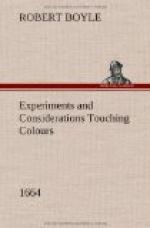4. A greater Disparity betwixt Emphatical Colours, and others, may perhaps be taken from this, that Genuine Colours seem to be produc’d in Opacous Bodies by Reflection, but Apparent ones in Diaphanous Bodies, and principally by Refraction, I say Principally rather than Solely, because in some cases Reflection also may concurr, but still this seems not to conclude these Latter Colours not to be True ones. Nor must what has been newly said of the Differences of True and Apparent Colours, be interpreted in too Unlimited a Sense, and therefore it may perhaps somewhat Assist you, both to Reflect upon the two fore-going Objections, and to judge of some other Passages which you’l meet with in this Tract, if I take this Occasion to observe to you, that if Water be Agitated into Froth, it exhibits you know a White colour, which soon after it Loses upon the Resolution of the Bubbles into Air and Water, now in this case either the Whiteness of the Froth is a True Colour or not, if it be, then True Colours, supposing the Water pure and free from Mixtures of any thing Tenacious, may be as Short-liv’d as those of the Rain-bow; also the Matter, wherein the Whiteness did Reside, may in a few moments perfectly Lose all foot-steps or remains of it. And besides, even Diaphanous Bodies may be capable of exhibiting True Colours by Reflection, for that Whiteness is so produc’d, we shall anon make it probable. But if on the other side it be said, that the Whiteness of Froth is an Emphatical Colour, then it must no longer be said, that Fantastical Colours require a certain Position of the Luminary and the Eye, and must be Vary’d or Destroy’d by the Change thereof, since Froth appears White, whether the Sun be Rising or Setting, or in the Meridian, or any where between it and the Horizon, and from what (Neighbouring) place soever the Beholders Eye looks upon it. And since by making a Liquor Tenacious enough, yet without Destroying its Transparency, or Staining it with any Colour, you may give the Little Films, whereof the Bubbles consist, such a Texture, as may make the Froth last very many Hours, if not some Days, or even Weeks, it will render it somewhat Improper to assign Duration for the Distinguishing Character to Discriminate Genuine from Fantastical Colours. For such Froth may much outlast the Undoubtedly true Colours of some of Nature’s Productions, as in that Gaudy Plant not undeservedly call’d the Mervail of Peru, the Flowers do often Fade, the same Day they are Blown; And I have often seen a Virginian Flower, which usually Withers within the compass of a Day; and I am credibly Inform’d, that not far from hence a curious Herborist has a Plant, whose Flowers perish in about an Hour. But if the Whiteness of Water turn’d into Froth must therefore be reputed Emphatical, because it appears not that the Nature of the Body is Alter’d, but only that the Disposition of its Parts in reference to the Incident Light is Chang’d, why may not the Whiteness be accounted Emphatical too, which I




